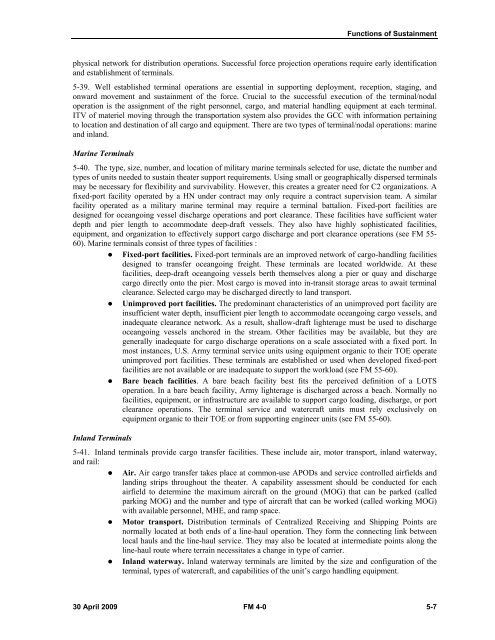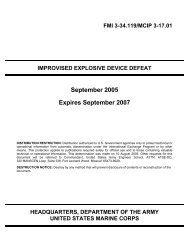FM 4-0, Sustainment - GlobalSecurity.org
FM 4-0, Sustainment - GlobalSecurity.org
FM 4-0, Sustainment - GlobalSecurity.org
- No tags were found...
You also want an ePaper? Increase the reach of your titles
YUMPU automatically turns print PDFs into web optimized ePapers that Google loves.
Functions of <strong>Sustainment</strong>physical network for distribution operations. Successful force projection operations require early identificationand establishment of terminals.5-39. Well established terminal operations are essential in supporting deployment, reception, staging, andonward movement and sustainment of the force. Crucial to the successful execution of the terminal/nodaloperation is the assignment of the right personnel, cargo, and material handling equipment at each terminal.ITV of materiel moving through the transportation system also provides the GCC with information pertainingto location and destination of all cargo and equipment. There are two types of terminal/nodal operations: marineand inland.Marine Terminals5-40. The type, size, number, and location of military marine terminals selected for use, dictate the number andtypes of units needed to sustain theater support requirements. Using small or geographically dispersed terminalsmay be necessary for flexibility and survivability. However, this creates a greater need for C2 <strong>org</strong>anizations. Afixed-port facility operated by a HN under contract may only require a contract supervision team. A similarfacility operated as a military marine terminal may require a terminal battalion. Fixed-port facilities aredesigned for oceangoing vessel discharge operations and port clearance. These facilities have sufficient waterdepth and pier length to accommodate deep-draft vessels. They also have highly sophisticated facilities,equipment, and <strong>org</strong>anization to effectively support cargo discharge and port clearance operations (see <strong>FM</strong> 55-60). Marine terminals consist of three types of facilities :• Fixed-port facilities. Fixed-port terminals are an improved network of cargo-handling facilitiesdesigned to transfer oceangoing freight. These terminals are located worldwide. At thesefacilities, deep-draft oceangoing vessels berth themselves along a pier or quay and dischargecargo directly onto the pier. Most cargo is moved into in-transit storage areas to await terminalclearance. Selected cargo may be discharged directly to land transport.• Unimproved port facilities. The predominant characteristics of an unimproved port facility areinsufficient water depth, insufficient pier length to accommodate oceangoing cargo vessels, andinadequate clearance network. As a result, shallow-draft lighterage must be used to dischargeoceangoing vessels anchored in the stream. Other facilities may be available, but they aregenerally inadequate for cargo discharge operations on a scale associated with a fixed port. Inmost instances, U.S. Army terminal service units using equipment <strong>org</strong>anic to their TOE operateunimproved port facilities. These terminals are established or used when developed fixed-portfacilities are not available or are inadequate to support the workload (see <strong>FM</strong> 55-60).• Bare beach facilities. A bare beach facility best fits the perceived definition of a LOTSoperation. In a bare beach facility, Army lighterage is discharged across a beach. Normally nofacilities, equipment, or infrastructure are available to support cargo loading, discharge, or portclearance operations. The terminal service and watercraft units must rely exclusively onequipment <strong>org</strong>anic to their TOE or from supporting engineer units (see <strong>FM</strong> 55-60).Inland Terminals5-41. Inland terminals provide cargo transfer facilities. These include air, motor transport, inland waterway,and rail:• Air. Air cargo transfer takes place at common-use APODs and service controlled airfields andlanding strips throughout the theater. A capability assessment should be conducted for eachairfield to determine the maximum aircraft on the ground (MOG) that can be parked (calledparking MOG) and the number and type of aircraft that can be worked (called working MOG)with available personnel, MHE, and ramp space.• Motor transport. Distribution terminals of Centralized Receiving and Shipping Points arenormally located at both ends of a line-haul operation. They form the connecting link betweenlocal hauls and the line-haul service. They may also be located at intermediate points along theline-haul route where terrain necessitates a change in type of carrier.• Inland waterway. Inland waterway terminals are limited by the size and configuration of theterminal, types of watercraft, and capabilities of the unit’s cargo handling equipment.30 April 2009 <strong>FM</strong> 4-0 5-7

















